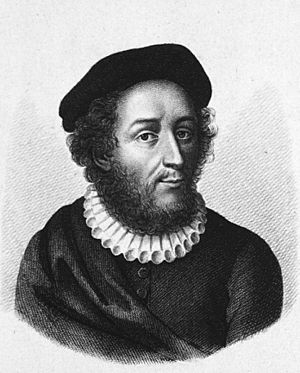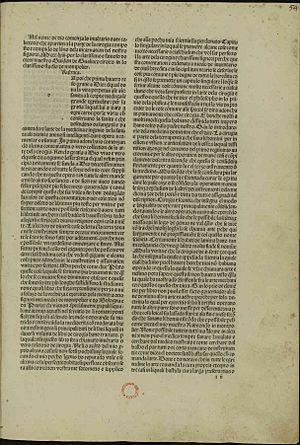Guy de Chauliac facts for kids
Quick facts for kids
Guy de Chauliac
|
|
|---|---|

A 16th-century depiction
|
|
| Born | c. 1300 Chaulhac, Lozère, France
|
| Died | 1368 (aged 67–68) Avignon, France
|
| Occupation | physician and surgeon |
| Medical career | |
| Notable works | Chirurgia Magna |
Guy de Chauliac (born around 1300 – died 25 July 1368) was a famous French doctor and surgeon. He wrote a very important book about surgery called Chirurgia Magna. This book was written in Latin but was translated into many languages. Doctors all over Europe read it during the Middle Ages.
A Doctor's Journey
Guy de Chauliac was born in a small town in France called Chaulhac. His family was not rich. He started studying medicine in Toulouse. Later, he went to Montpellier, which was a top place for medical learning in France.
He studied in Paris between 1315 and 1320. Around 1325, he became a Master of Medicine and Surgery. After his studies, he went to Bologna to learn about anatomy. He may have learned surgical skills there.
Working for Popes
Guy de Chauliac became a very respected doctor. He was asked to work for the Pope in Avignon, France. He was the personal doctor for three Popes:
- Pope Clement VI (from 1342 to 1352)
- Pope Innocent VI (from 1352 to 1362)
- Pope Urban V (from 1362 to 1370)
He died in Avignon in 1368. He finished his most important book in 1353.
Facing the Black Death
When the terrible disease called the Black Death reached Avignon in 1348, many doctors ran away. But Guy de Chauliac stayed. He treated people who were sick with the plague. He carefully wrote down what he saw about the disease. He even said he got sick himself but survived.
Through his observations, Chauliac noticed two main types of the disease:
- The Bubonic Plague
- The Pneumonic Plague
He advised Pope Clement VI to keep a fire burning in his room all the time. He also told the Pope to avoid visitors. This was to help prevent the spread of the disease.
Chauliac described the plague to the Pope's court: "The great death began in January [1348] and lasted for seven months. It had two forms. The first lasted two months, with fever and spitting blood. Death happened within three days. The second form lasted the rest of the time, also with fever, and with sores and boils on the body, especially under the arms. Death happened within five days. It was so contagious (especially when people spit blood) that you could catch it just by looking at someone."
Doctors knew the plague was contagious, but they didn't know what caused it. Chauliac suggested cleaning the air and having a healthy diet. He also recommended venesection (bleeding). Some people blamed Jewish people for the plague, saying they poisoned wells. Guy de Chauliac used science to show that this idea was wrong.
His Important Books
Chirurgia Magna
Chauliac's most famous book on surgery is called Chirurgia magna. He finished it in 1353 in Avignon, right after the Black Death. This book has seven parts. It talks about:
- Anatomy (how the body is built)
- Bloodletting (removing blood)
- Cauterization (burning tissue to stop bleeding)
- Medicines
- Anesthetics (things to make you numb)
- Wounds and broken bones
- Ulcers
- Special diseases
- Antidotes (cures for poisons)
He wrote about using oakum (loose fibers) and bandages with egg whites. He also described surgical methods like intubation (putting a tube into the body), tracheotomy (making an opening in the windpipe), and suturing (stitching wounds). He even described using anesthetic gas for amputations.
Chauliac often quoted other medical books in his work. He wanted to show the history of medicine. He believed surgery started with Hippocrates and Galen. He also said it grew in the Arab world with doctors like Haly Abbas, Albucasis, and Al-Razi. Because he was the Pope's doctor, Chauliac could read new translations of Galen's texts. These were more accurate than older Latin versions.
Chirurgia magna was also greatly influenced by Islamic scientists. Chauliac often mentioned Avicenna in his book. The book became very popular. It was translated into English, French, Dutch, Italian, and Provençal. It was even translated into Irish. Over time, the book was changed many times. Sometimes, parts about Islamic scientists were removed.
Why Anatomy Matters
Galen was a big influence on Chauliac. Chauliac believed that surgeons must know a lot about anatomy. He wrote, "A surgeon who does not know his anatomy is like a blind man carving a log." This means a surgeon needs to understand the body's structure.
Other Writings
Guy de Chauliac wrote three other books:
- Practica astrolabii: This was about astrology.
- De ruptura: This book described different types of hernias.
- De subtilianti diaeta: This explained treatments for cataracts.
See also
 In Spanish: Guy de Chauliac para niños
In Spanish: Guy de Chauliac para niños


